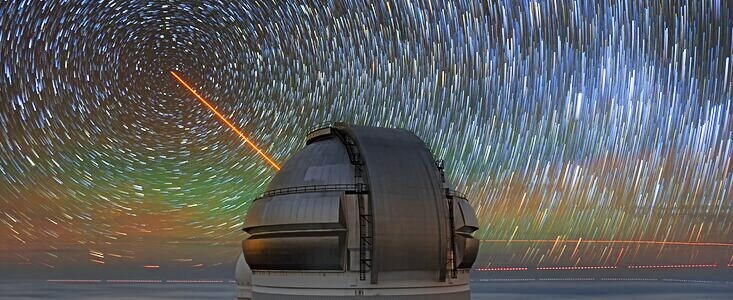The National Science Foundation (NSF) and SpaceX have finalized a coordination agreement to mitigate the impact of the company’s Starlink satellites on ground-based radio-, optical-, and infrared-astronomy facilities. The NSF’s public statement is here.
“We are setting the stage for a successful partnership between commercial and public endeavors that allows important science research to flourish alongside satellite communication,” said NSF Director Sethuraman Panchanathan.
NSF’s NOIRLab serves as the key point of contact for technical exchanges with SpaceX on optical and infrared issues and NSF’s National Radio Astronomy Observatory for radio-astronomy issues. NOIRLab also provides community leadership on mitigation issues by co-hosting the IAU Centre for the Protection of the Dark and Quiet Sky from Satellite Constellation Interference (CPS).
“Without close coordination and cooperation, satellite constellations will have an unprecedented impact on our view of the cosmos and negatively impact astronomical research,” said NOIRLab Director Patrick McCarthy. “It is heartening to see that we are making important strides so that satellite-service providers can meet their objectives while protecting the night sky for astronomy and the enjoyment of future generations.”
SpaceX is launching and operating its satellite constellation in low-Earth orbit to provide high-speed internet service. More than 3000 satellites currently comprise SpaceX’s Starlink network, which provides high-speed internet to more than 600,000 locations in the United States, often in remote or previously unserved and underserved areas. Some of the frequencies in which the satellites transmit toward Earth are adjacent to radio astronomy allocations. Operating the satellites without mitigations could impact ground-based radio, optical and infrared astronomy facilities.
The agreement, detailed in a statement released by NSF today, ensures that Starlink satellite network plans will meet international radio astronomy protection standards while working toward recommendations that came from NSF’s NOIRLab and the AAS’s SATCON workshops and the IAU’s Dark and Quiet Skies best practice guidance.
These recommendations include continuing to work to reduce the optical brightness of their satellites to 7th visual magnitude or fainter via darkening, deflecting light away from the Earth, attitude maneuvering, or other ideas to be developed; maintaining orbital elevations at ~700 kilometers or lower; and providing orbital information publicly that astronomers can use for scheduling observations around satellite locations.
Details of these mitigations and ongoing work were presented at the 2022 Vera C. Rubin Community Workshop and are available here.
SpaceX agreed to analyze the impact of astronomical facility lasers on its satellites. Following this analysis, the Laser Clearinghouse, which is a branch of the US Space Command tasked with ensuring orbital assets are not negatively impacted by lasers, removed the coordination requirements for these lasers. The change means that adaptive optics lasers at ground-based facilities will no longer suffer closures every time the SpaceX satellites pass near an observed region of sky. SpaceX is also working with NOIRLab to organize a workshop to develop best practice guidance on these topics. The workshop will recommend processes for interactions between satellite operators and the Laser Clearinghouse aimed at mitigating negative impacts on ground-based astronomical facilities.
“NSF and SpaceX have collaborated from the beginning on how best to meet the goals of protecting astronomy while also providing maximum internet access for communities across the United States. The mitigation steps taken can and should serve as a model for coordination among satellite operators and the astronomy community within the United States and beyond,” said NSF in their statement.
More information
NSF’s NOIRLab (National Optical-Infrared Astronomy Research Laboratory), the US center for ground-based optical-infrared astronomy, operates the International Gemini Observatory (a facility of NSF, NRC–Canada, ANID–Chile, MCTIC–Brazil, MINCyT–Argentina, and KASI–Republic of Korea), Kitt Peak National Observatory (KPNO), Cerro Tololo Inter-American Observatory (CTIO), the Community Science and Data Center (CSDC), and Vera C. Rubin Observatory (operated in cooperation with the Department of Energy’s SLAC National Accelerator Laboratory). It is managed by the Association of Universities for Research in Astronomy (AURA) under a cooperative agreement with NSF and is headquartered in Tucson, Arizona. The astronomical community is honored to have the opportunity to conduct astronomical research on Iolkam Du’ag (Kitt Peak) in Arizona, on Maunakea in Hawai‘i, and on Cerro Tololo and Cerro Pachón in Chile. We recognize and acknowledge the very significant cultural role and reverence that these sites have to the Tohono O’odham Nation, to the Native Hawaiian community, and to the local communities in Chile, respectively.
Contacts
Pat McCarthy
NSF’s NOIRLab
Director
Email: [email protected]
Julian Christou
NSF’s NOIRLab
Adaptive Optics Specialist
Email: [email protected]
Connie Walker
NSF’s NOIRLab
Scientist, Observatory Site Protection
Email: [email protected]
Charles Blue
Public Information Officer
NSF’s NOIRLab
T: +1 202 236 6324
Email: [email protected]


